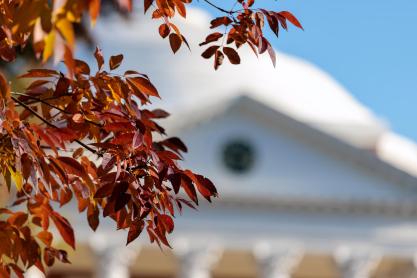Native to China, India and Vietnam, the spotted lanternfly has been detected in 17 states and in many counties across Virginia, including Albemarle.
We caught up with Roulston for more information on the insect – and what you can do to stop its spread.
Q. What causes them to be so invasive?
A. They have very few natural enemies here, so there’s not anything to keep them in check. And their preferred host plant is one of the weediest trees in our area. If you want to pick a ship to sail in your adventure in the new world, they picked a great one because the tree of heaven is so abundant along our roadsides and in forested areas.
And there’s nothing else that eats it. So, they have a really good food source (in the tree of heaven). They also acquire toxic compounds from that food source that makes them unpalatable to birds.
Q. What are they doing to these trees to cause damage?
A. They’re related to aphids and leaf hoppers, which will tap into the circulatory system or the fluid system of the tree, so they’ll be feeding from the tree sap. They process it; it goes as fecal material out the back of them and then falls. That’s what’s euphemistically called “honeydew.”
There’s a lot of sugar in it, and it’s very dilute. It’s sticky. That will fall on leaves. When you’ve got hundreds or thousands of them feeding in a tree, all the leaves can get covered with it, and that attracts mold. Then you get black mold forming on top of the leaves, and then the leaves are no longer photosynthesizing.
And then there’s damage from the feeding itself. You can see many hundreds on a single tree, probably thousands on a single tree, all feeding together.
Q. If you spot one, what should you do?
A. This is one of the few times that you are commonly encouraged to just smash them with whatever you can. You have adult permission to exuberantly stomp on them.
They are hard to catch. They move quickly. The adults will jump away once and then jump away a second time, but they won’t go so far. By the third time, they can’t get away. They have one really good jump in them, and then after that, they’re out of gas.
If you’re in an area where (the spotted lanternfly) is not known to have reached yet, then you’re encouraged to photograph them and send the photograph to the local extension agent.
Q. Are they harmful to humans or pets?
A. No. They’re not harmful to humans. Nothing seems to like the taste. A pet might eat one of them and spit it out.
Q. Is there anything you can put on trees to protect them?
A. They can do pesticide injections in the trees so that when the insects feed on them, they die in feeding. And that’s been done in various places to particular trees.
One of the recommendations for a while has been to remove as many trees of heaven as possible but leave a couple of them around that get injected with pesticide. Then, all the spotted lanternflies will gather on it and then die. So that has been one approach to it. And because the tree of heaven is fed upon by very few insects directly, there’s not a lot of risk to other insects unless those pesticides end up in the flowers, and then you have a certain risk to pollinators. Those studies are still being done, looking at what kind of risk that poses.
The other approach is to put sticky bands on trees that capture the insects when they’re crawling up the tree, because spotted lanternflies tend to land low on the tree and then crawl up. But sticky bands must be done very carefully. If you put that outside of a tree, then anything can get stuck in it, including birds and rodents and things.
Q. Should you be checking your car for them before driving?
A. Yeah, that’s an important thing, especially if you are driving out of your local area. The adults can hang on well and hitchhike, but probably the biggest concern is the egg cases.
They’ll lay about 50 eggs at a time in this square, little chalky-colored patch, and they will lay the eggs on just about any smooth surface. So they will lay them on tree bark. They will lay them on cars. They will lay them on cement – pretty much anything. You could easily move them with a wood pile.
When an area goes under quarantine (such as Albemarle County), then you’re prohibited from transporting wood out of the area into non-quarantined areas because you’ve got a very good chance of having egg cases on there.
Q. Beyond the tree of heaven, what else can they harm?
A. Vineyards should worry a lot. Wild grapes, commercial grapes as well, are one of the favorite host plants for them, and they can do a lot of economic damage to them. They can really reduce production. It’s something vineyards want to try to control in their area. The first thing is trying to recognize whether there’s any tree of heaven anywhere around the vineyards and removing that to reduce the sources of spotted lanternflies.
But they’re just going to have to watch out for the infestations to start. Spotted lanternflies don’t fly that well, but once they get established very close, then they’re going to spread all over the vineyards.














